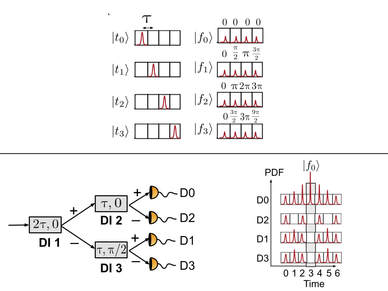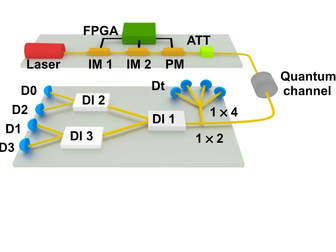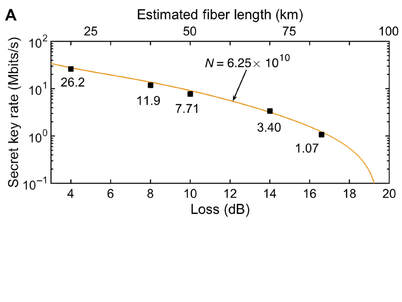|
Quantum Key Distribution, or how to communicate encrypted information in a totally secure manner, has gone from being an idea to being a commercial possibility in thirty years. In a recent paper in Science Advances, researchers from Duke University, Ohio State University and Oak Ridge National Laboratory have beaten a new record with their multi-dimensional qdit encoding (Islam et al., Sci. Adv. 2017;3: e1701491, 24 November 2017).
 The idea of superposition, i.e., having for example 50% vertically polarized and 50% horizontally polarized, is unique to quantum mechanics. Once we measure the polarization of the photon it will be either horizontally or vertically polarized, but we can generate photons that will be in a superposition state until it is measured. The no-cloning theorem states that it is not possible to clone a quantum state, so we cannot observe a photon and copy exactly the original state of the photon. This way, if Alice wants to communicate with Bob, they can use a protocol to detect any eavesdropper. But more than that, they can generate a protocol to account for possible attacks and still distill a secured key. Bennet and Brassard described their protocol using the polarization of photons: vertical is 1, horizontal is 0. But since then other ways of encoding the information have been developed. The group of Islam et al. has used time-bin encoding. They encode the information in the time of arrival of the photon. They generate time bins and each one of them corresponds to one bit of information. One advantage of this is that they can encode more than two bits of information in each photon. They have generated four time bins (see figure), so they can send pulses of photons in four different positions. Then, at the detection side, they interfere the pulses with themselves. To do this they use three unbalanced interferometers. Because the interferometers are unbalanced they interfere different time bins. This way they can track the visibility of the interference, and compare the experimental visibility with the expected one, in order to secure the communication.  Because in the path from Alice to Bob there can be looses, all QKD protocols have limitations. At some distance no photons will be expected to arrive, and only detections coming from dark counts, or straight light will be registered. The fact of encoding more than just on bit of information per photons makes this protocol more robust against looses (for qbits it would be d=2 while here it is d=4). The researchers have also used Superconducting Nanowire Single Photon Detectors (SNSPD). These detectors have high detection efficiency, very low dark count rates (clicks not related with detected photons), and low saturation . The only drawback of these detectors is that, in order to avoid thermal noise they need to work at 4K. But there is being an important development in these devices recently. This helps the communication rate, which is one of the problems towards a commercialization: if QKD protocols cannot transmit as fast as classical systems, it will not be practical.  This work puts a new record at 26.2 Megabits per second for 20 km, and 1.07 Megabits per second for 83 kilometers. This is 10 times larger than previous research.
24 Comments
|
Andrés AragonesesPhysicist, working in quantum optics and nonlinear dynamics in optical systems. Loves to communicate science. Archives
January 2018
Categories |
 RSS Feed
RSS Feed
